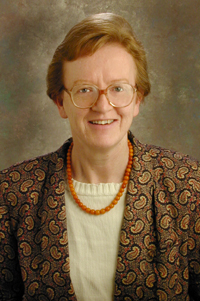|
 |
 |
 |
| Victorian women’s groups often defined ‘common good’ in narrow terms |
| |
 |
| Anne M. Boylan, professor of history and women’s studies: “Women who led well-funded and socially accepted associations spoke about promoting the ‘common good,’ and assumed that their version of the ‘common good’ was the only possible one.” |
1:05 p.m., Jan. 17, 2003--Anne M. Boylan, professor of history and women’s studies at the University of Delaware, traced the roots of 19th-century women’s activism for her new book, “The Origins of Women’s Activism.”
Boylan studied women’s benevolence and reform groups of every stripe in New York and Boston—looking at the ways class, race and religion brought women together or kept them apart.
Although volunteering is often promoted as a remedy for social ills, Boylan’s research showed most 19th-century women’s volunteer groups promoted the interests of the powerful, often at the expense of the powerless.
“Women who led well-funded and socially accepted associations spoke about promoting the ‘common good,’ and assumed that their version of the ‘common good’ was the only possible one,” Boylan said. “Women who might challenge that version, such as poor and working-class women forming mutual assistance societies, simply didn’t have the resources and influence to promote their alternative idea of what constituted the ‘common good.’”
Boylan concluded that the women activists interpreted problems from their vantage point. She said working-class white women and black women were often the targets of middle-class white women’s efforts to “shape up” working-class families by indenturing their children or criticizing their household budgeting.
“Working-class women usually were working, earning money. They knew how hard it was to live on women’s wages,” Boylan said. “Middle-class white women had breadwinning husbands who earned good salaries, so they saw the solution to working-class women’s problems through the lens of their own experience. It’s not that they weren’t compassionate, because they were, but they had a very limited conception of what the lives of working-class women were like.”
She found volunteer work usually reflected women’s pre-existing interests and concerns, although she said temperance reformers were one example of women who learned from their association with poor women. Their work with poor urban women convinced them that men’s alcohol use was a major cause of domestic violence.
Boylan sandwiched her research between her family activity and her University duties, traveling to archives in New York and Boston for more than two decades. She was surprised to learn that most leaders of early women’s organizations balanced their work with marriage and children, too.
“This was an era when ‘domesticity’ was held up as an ideal, yet the women I studied were doing both: They were running organizations at the same time that they were embedded in the daily experience of being wives and mothers,” Boylan said. “And, no one criticized them for neglecting their families or being unwomanly—unless, of course, the activities of their organizations challenged existing social arrangements. Only women abolitionists, not women orphanage founders, were the targets of such criticisms.”
Boylan said the early activists had far-ranging effects locally and nationally.
She said the local orphanages they founded changed the way cities and towns handled young children whose fathers had died and sometimes offered more opportunities for education and training.
National women’s associations, which flourished after the Civil War, promoted historical changes, such as women’s suffrage, factory inspection, the regulation of consumer goods, the creation of the juvenile court system, the creation of historical museums, the unionization of women workers, the expansion of state functions and efforts to end lynchings in the South, Boylan said.
“The Origins of Women’s Activism” is published by University of North Carolina Press.
A member of the UD faculty since 1986, Boylan is a social historian of the 19th-century United States and of women and gender. A graduate of Mundelein College, she earned her doctorate at the University of Wisconsin-Madison. Boylan also is the author of several articles and an earlier book, “Sunday School: The Formation of an American Institution, 1790-1880.”
Article by Kathy Canavan
Photo by Jack Buxbaum
|
|

